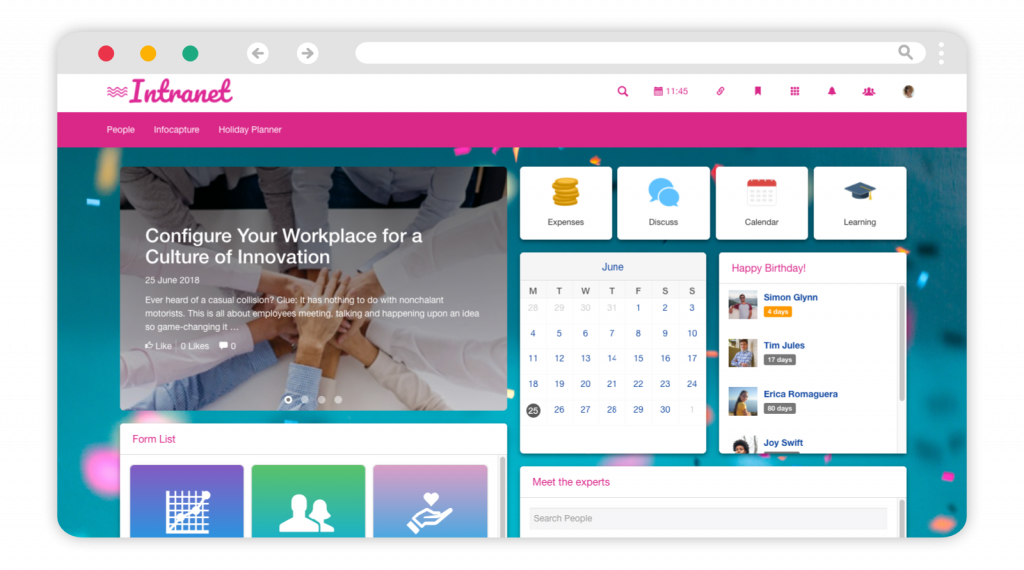Cross team collaboration has always been vital for innovation and long-term business growth. Arguably, however, it’s a process that has always been easier said than done.
Communication issues, siloed expertise and good old-fashioned workplace politics have long been a thorn in the side of cross-functional projects.
Now, with remote teams and home working on the rise thanks to the COVID 19 pandemic, you’ll need to facilitate the already-tricky process of cross team communication. This will sit across a logistically-challenging remote environment.
The good news? With the right approach and with the right collaboration software alongside it, you can improve cross team collaboration across your organisation – even during less-than-optimal working conditions.
Use the best practices below to encourage cross functional teams to collaborate more efficiently, regardless of what the pandemic throws at them.
1. Strengthen social bonds between departments
In busy departments, it’s all too easy for an ‘us versus the world’ mentality to develop. Employees fight against the competing priorities of other stakeholders, rather than focusing on joint progress towards a common goal.
In many cases, this is because people don’t socialise with those outside of their function. Whilst email and instant messaging tools have revolutionised the way we work, it’s far easier to ignore text on a screen than face-to-face interactions in a meeting or video call.
Under normal circumstances, your best course of action would be regular face-to-face meetings, with plenty of opportunity for socialising afterwards. Regular social events, like Christmas parties, summer fetes and awards evenings, also contribute to a sense of community with those outside of your own department.
Right now, however, you’ll need to get a little more creative. Video conferencing, virtual happy hours and creating dedicated channels on your instant messaging app for general social chat, allow team members to bond over topics outside of work (‘pet pics’ has been a pandemic favourite for numerous organisations).

Alternatively, you could leverage a social intranet to encourage employees to make connections across the business virtually, to see themselves as part of a wider operation.
2. Senior members of staff must encourage cross team collaboration
Never underestimate the impact that executive buy-in can have on cross functional collaboration.
Senior management involvement has a unifying effect on cross functional teams due to:
- Experience and leadership, thanks to years of working across different teams
- Strategic, company-wide insight – this helps everyone identify a common goal and work towards it
Strong unifying effects like these have an immediate effect on the perceived need for collaboration and focus, whilst offering employees advantages in return.
3. Use a collaborative intranet to share best practices
Encourage collaboration by offering extensive, easily accessible online collaboration tools that help share best practices and reduce inefficiencies in cross departmental projects.
Remote team software like cloud intranet solutions, for example, can be accessed by any employee, anywhere – and if you have a mobile-friendly intranet app, all the better. These offer the following benefits:
- Less time lost to difficult-to-follow email chains and confusion over document versions, thanks to instant messaging tools and centralised document management
- A better flow of information and best practices across your organisation due to inbuilt social media feeds and project discussion forums
- Remote teams and home workers feeling more connected to those working at company headquarters – and being more engaged and willing to contribute as a result
Particularly when coupled with other collaboration software, like project management software, a collaborative intranet makes it so much easier to communicate effectively.
Intranets are also fantastic tools for removing silos between departments which are detrimental to business collaboration. By providing access to company-wide expertise on best practices and collaborative working, intranets offer cross collaborative teams a greater depth of experience to draw from. This makes innovative idea generation faster, easier and more informed.

4. Create a team charter to improve cross team collaboration
Before you start a cross collaborative team project, it’s important to make sure everyone knows what the goals of the project are and what it requires from them.
It’s helpful to have a written record of this, for the sake of accessibility and transparency. Drawing up a ‘team charter’, which everyone agrees to before the project starts, makes sure everyone is on the same page and can prepare accordingly.
This should outline:
- The purpose of the team and project
- How purpose fits into wider strategic objectives for your organisation
- Key roles – such as project managers, senior sponsors or subject matter experts
- What budget and resources you have at your disposal
- Key delivery dates for project milestones and overall completions
- Expectations of employee behaviour throughout the project and key performance indicators
Store the team charter somewhere where all team members can access it. If your intranet has document storage, this is an ideal solution because it’s immediately accessible to everyone.
Often, cross team collaboration is undermined by lack of cohesion on overarching objectives. It’s all too easy for the marketing team to take one view of what the goals are, the sales team a second, your customer service department a third, and so forth.
Setting common goals down in writing avoids communication difficulties arising partway through the project. Stress and bad feeling among team members is reduced as a result and collaborative efforts are more successful overall.
Summing up: a four-step plan of action
The more cross team collaboration results in successful outcomes, the more your employees will want to engage with it.
Creating this spiral of success, however, relies on building solid foundations. It might be helpful to divide these into four main categories:
- Encourage social bonds between different departments
- Achieve visible buy-in from senior management for cross collaborative projects
- Use online collaboration tools to communicate effectively and share best practices
- Establish key objectives, milestones and outcomes early in the collaborative process
Once you have these cornerstones in place, it becomes much easier to encourage cross team collaboration across your business – and employees will start seeing it as a natural, necessary process for business growth, rather than a professional minefield.





